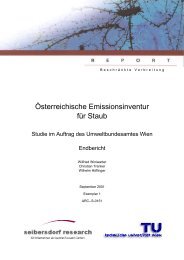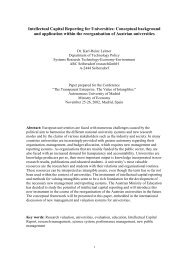ALPMON FINAL REPORT - ARC systems research
ALPMON FINAL REPORT - ARC systems research
ALPMON FINAL REPORT - ARC systems research
Create successful ePaper yourself
Turn your PDF publications into a flip-book with our unique Google optimized e-Paper software.
Contract ENV4-CT96-0359 <strong>ALPMON</strong><br />
framework of a hydrological modelling project because of economic and time constraints. For this<br />
application, therefore, following procedure was applied to derive the soil type information. As the basis<br />
for the estimation of soil-types, the soil-type map of Styria 1:1.000.000 (Krainer et al., 1998), the<br />
geological map of Styria 1:50.000 in digital format, and point-wise available soil analysis data (Krainer<br />
et al., 1998) were used. The result is an “estimated soil type distribution” of the catchment area, with<br />
the 1:50.000 scale of the geological map and the soil type information of the 1:1.000.000 scale soil type<br />
map. The so derived parameters can only give a rough estimate of the actual soil parameters.<br />
However, major improvements on the soil type distribution information, e.g. detailed delineation of<br />
valley bottoms, alluvial cones etc. result from this procedure.<br />
The applied TOPMODEL approach is based on the saturated area approach using the topographic<br />
index after Beven and Kirkby (1979). This statistically based model differs from earlier soil-vegetation<br />
process models by including spatial variations in the main driving processes and uses topographic<br />
HRU’s to calculate lateral soil water transport. The recession parameter m was determined by slope<br />
hydrograph analysis. The main parameter of the TOPMODEL approach, the soil-topographical index,<br />
has been derived from the DEM. According to the saturated area theory, a higher index indicates a<br />
higher chance to contribute to the direct runoff. Thus, the areas with the highest indices simultaneously<br />
represent the river network.<br />
The first model output results for the Sulm gauge in Leibnitz are displayed in Figure 5 for the time<br />
period from April until September 1999. Figure 5 shows the measured and simulated hourly runoff of<br />
the basin Sulm.<br />
Figure 5: Measured and simulated runoff for the basin Sulm from April to September 1999.<br />
For the period April to September 1999 the Nash-Sutcliffe coefficient was determined (Nash &<br />
Sutcliffe, 1970). The calculated “Explained Variance Coefficient” of 0.7 indicates a fair representation<br />
of the hydrology of the Sulm catchment.<br />
2.3.2.7 Conclusion<br />
Distributed models such as ASGI require land cover data for parameterisation. The use of earth<br />
observation data can be seen as an important pre-requisite for such models, as the spatial data<br />
demand for large area applications could hardly be satisfied without earth observation derived data<br />
sets (compare e.g. cost-estimates for land-cover mapping given by Konecny, 1995) . This leads to the<br />
conclusion that earth observation data support the application of distributed models, thus extending the<br />
toolbox of hydrologists.<br />
2.3.3 Avalanche Risk Assessment, Dachstein Test Site (JR)<br />
2.3.3.1 Introduction and Objectives<br />
Increasing public and private construction activities have led to increased pressure on the valleys of the<br />
Alps. In order to prohibit uncontrolled building activities in torrent and avalanche danger zones, hazard<br />
JR, RSDE, ALU, LMU, Seibersdorf, WSL 37




